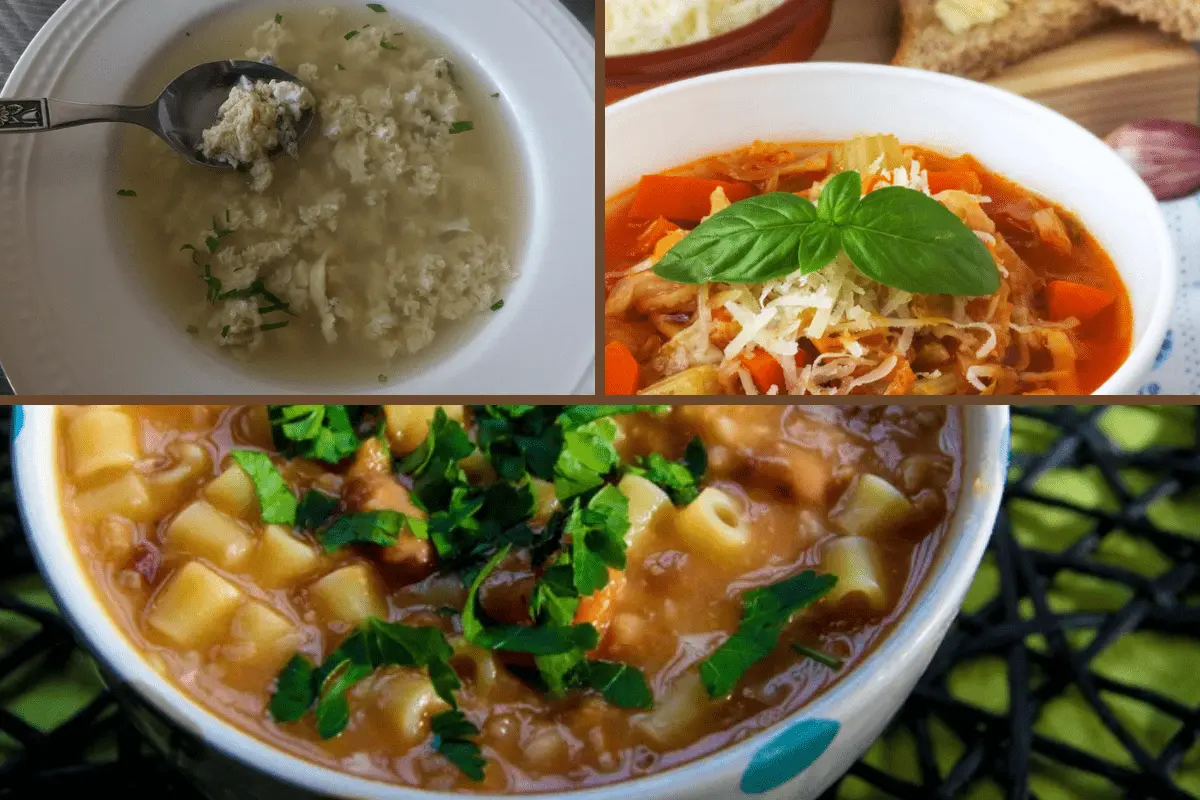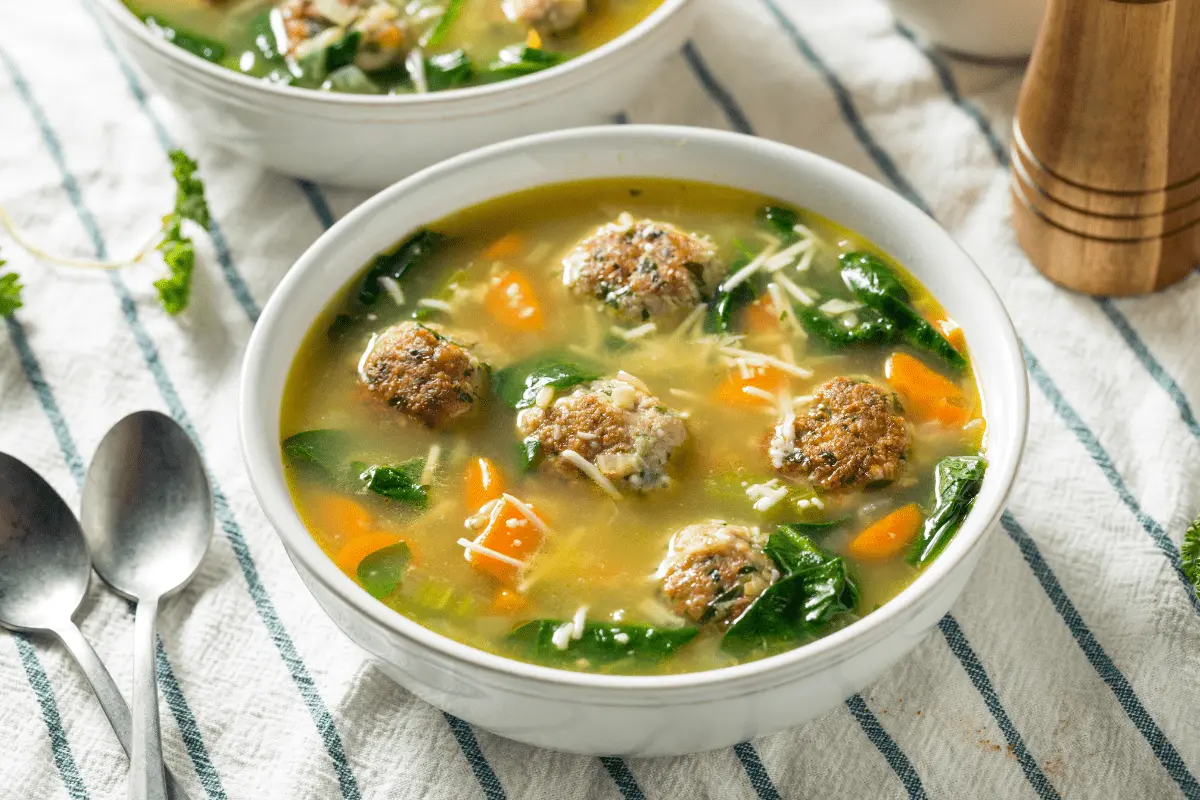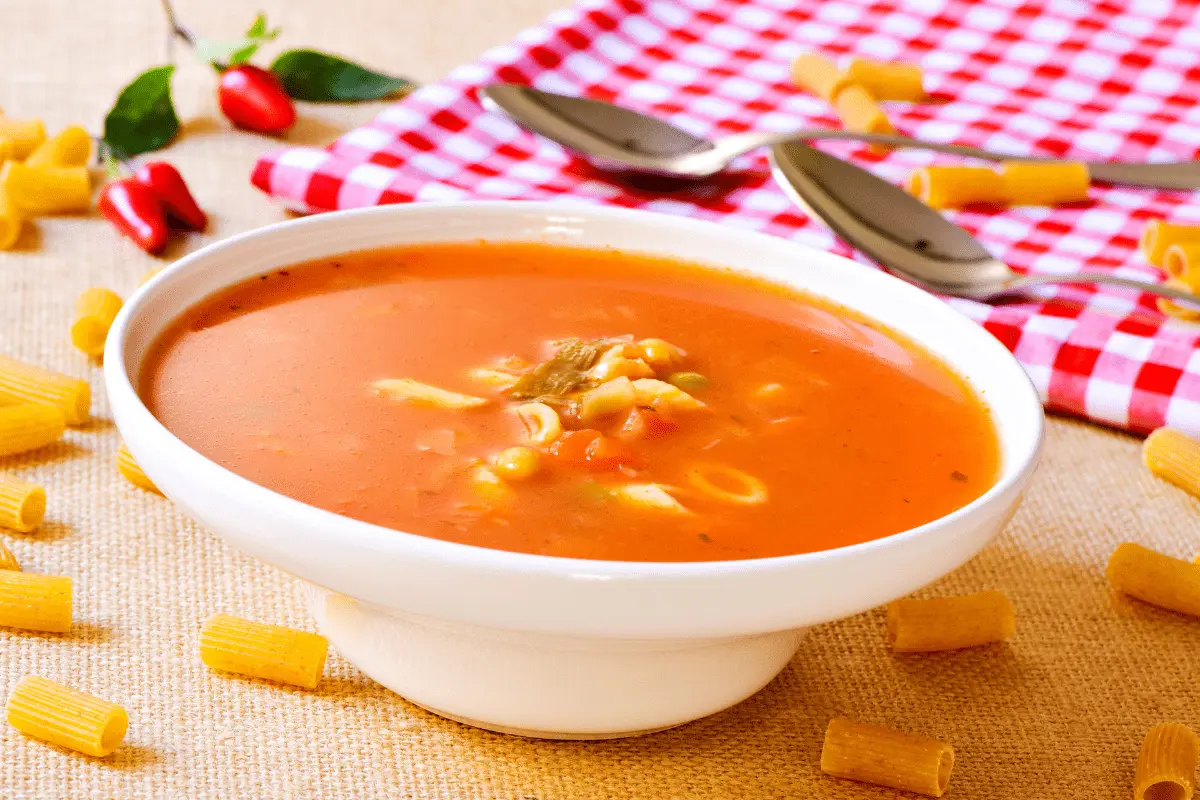Italy, renowned for its culinary excellence, offers a diverse palette of flavors, particularly in its soups. In this article, we explore what is the most popular soup in Italy, delving into the heart of Italian cuisine. We’ll discover the beloved soups that have become staples at Italian dinner tables. From the rustic charm of Ribollita to the comforting embrace of Minestrone, each soup narrates a tale of regional traditions, seasonal ingredients, and culinary innovation. Join us on this flavorful journey through Italy’s soup culture, where each spoonful is a taste of history and passion.
Introduction to Italian Soups: The Rich Soup Culture of Italy
Italy’s soup culture, as rich and varied as its history, showcases the diversity of the country’s culinary traditions. Each region has its unique soup, reflecting local ingredients and culinary practices. These soups, integral to Italian cuisine, are more than mere dishes; they are a testament to Italy’s deep-rooted love for food and an embodiment of the Italian way of life.
In the north, soups often feature hearty ingredients like beans and meats, suitable for the colder climate. In contrast, the south favors lighter, vegetable-based broths, highlighting the region’s sun-kissed produce. Across Italy, soups serve as a canvas for creativity and resourcefulness, often born out of necessity and perfected over generations.
Italian soups, more than starters or sides, often stand as the meal’s heart, rich in nourishment and flavor. They embody cucina povera, Italy’s philosophy of simple, no-waste cooking that turns basic ingredients into culinary wonders.
From Rome’s vibrant streets to Tuscany’s tranquil countryside, each soup offers a taste of the Italian soul. It’s about more than flavor. It’s about the warmth of family gatherings, the joy of shared meals, and the tradition of passing down recipes through generations.
The Most Popular Soups in Italy
Penicillin Soup: Italy’s Healing Broth
Penicillin Soup, distinct from the antibiotic, is a prime example of Italy’s talent for creating nourishing, medicinal foods. Traditionally prepared in colder months or for illness recovery, it’s packed with healing ingredients. Garlic, known for its antibacterial and immune-boosting properties, is a key component. This soup typically combines a rich broth with vegetables and sometimes chicken, simmered into a comforting, healing bowl.
Furthermore, this soup reflects the Italian tradition of using food as medicine, a concept deeply ingrained in Italy’s culinary history. Each bowl of Penicillin Soup blends tradition, care, and nature’s healing power, making it a treasured part of Italy’s diverse soup collection.
Pasta e Ceci: A Classic Choice
In the realm of Italian soups, Pasta e Ceci stands out as a classic example of what is the most popular soup in Italy. This soup, blending pasta and chickpeas, showcases the simplicity of Italian cooking. Originating from Italy’s heart, it varies slightly by region but always warms the heart. Its charm comes from the soffritto base – onions and celery sautéed and simmered in rich chickpea broth. The pasta, from maltagliati to cannolicchi, adds delightful texture.
Ribollita: Tuscany’s Pride
In Tuscany, Ribollita is a prime example of what is the most popular soup in Italy in this region. This thick, bread-based soup is a celebration of humble ingredients transformed into a feast. Ribollita, meaning ‘reboiled’, is traditionally served the day after its preparation, allowing the flavors to deepen. Its core ingredients include leftover bread, cannellini beans, and a medley of seasonal vegetables like kale, onions, carrots, and cabbage. Each family in Tuscany may have their own version, but the essence of Ribollita remains the same – a rustic, hearty dish that embodies the spirit of Tuscan cuisine.
Pappa al Pomodoro: A Tomato Delight
Pappa al Pomodoro, another Tuscan gem, demonstrates the versatility of tomatoes in what is the most popular soup in Italy in this region. This thick soup marries fresh tomatoes with bread, olive oil, basil, and garlic, creating a dish that is both simple and profoundly flavorful. The authentic version insists on using costoluto fiorentino tomatoes and pane toscano bread, ensuring a taste that is quintessentially Tuscan. Pappa al Pomodoro’s history dates back to 1911, but its roots are likely much older, reflecting the ingenuity of turning basic ingredients into a dish that is both nourishing and delicious.
Passatelli in Brodo: Emilia-Romagna’s Specialty
From Emilia-Romagna, Passatelli in Brodo is a unique soup that showcases the region’s love for hearty, comforting dishes, and is a strong contender for what is the most popular soup in Italy in this area. This soup features dumplings made from cheese, bread, and eggs, swimming in a savory meat broth. It’s a dish born from cucina povera, where limited ingredients are elevated into something truly special. The soup is often paired with a simple red wine like Sangiovese, creating a perfect harmony of flavors.
Minestrone: A Versatile Vegetable Soup
Minestrone, perhaps Italy’s most famous soup, is known for its versatility and vegetable-packed goodness. This thick soup has roots dating back to Roman times and varies significantly from region to region. The common thread is a base of stock, onions, tomatoes, celery, carrots, and legumes, simmered to bring out the depth of flavors. Minestrone is a celebration of seasonal produce, with each region adding its own twist, making it a true reflection of Italy’s diverse culinary landscape and a key example of what is the most popular soup in Italy.
Pasta e Fagioli: A Hearty Staple
Pasta e Fagioli, often affectionately called ‘pasta fazool’ in some parts of the world, is a staple in Italian households and a strong example of what is the most popular soup in Italy. This hearty soup combines beans and pasta in a rich broth flavored with olive oil, onions, celery, carrots, garlic, and tomatoes. It’s a dish that started as peasant food but has become a beloved classic, known for its comforting and filling qualities. The texture can range from soupy to thick, but the warmth and satisfaction it delivers are constant.
Ingredients and Preparation:
Common Ingredients in Italian Soups
Italian soups are a mosaic of flavors, each ingredient playing a crucial role in creating a harmonious blend. The foundation of many Italian soups is the soffritto – a mix of finely chopped onions, carrots, and celery, sautéed in olive oil. This trio, known as the holy trinity of Italian cuisine, provides a depth of flavor that is unmistakably Italian.
Beans, both dried and fresh, are another staple in Italian soups, offering texture and protein. Cannellini beans are particularly popular, featured in classics like Ribollita and Pasta e Fagioli. Tomatoes, garlic, and fresh herbs like basil and thyme add freshness and aroma, while various types of pasta and bread bring heartiness and substance to the soups.
Cheese, especially Parmigiano-Reggiano, often serves as a finishing touch, adding a layer of richness and umami. In soups like Passatelli in Brodo, cheese is even incorporated into the dumplings, showcasing its versatility beyond just a garnish.
Traditional Preparation Methods
The magic of Italian soups lies not just in their ingredients but also in their preparation. Slow cooking is a hallmark of many Italian soups, allowing flavors to meld and intensify over time. This method is particularly evident in soups like Minestrone, where a medley of vegetables is simmered to perfection.
Another key aspect is the use of seasonal and fresh ingredients. Italian cooking is deeply connected to the seasons, with soups often reflecting the produce available at the time. This approach not only ensures the freshest flavors but also ties the dishes to the rhythms of nature and the Italian landscape.
In many Italian households, soup preparation is a ritual, a way to bring the family together. Recipes are passed down through generations, each adding their own touch, making the soups not just a meal but a part of the family’s heritage.
The process of making these soups is as comforting as consuming them. It’s a labor of love, from the careful chopping of vegetables to the slow simmering of the broth, culminating in a dish that is both nourishing and soul-warming.
Regional Variations of Italian Soups
Northern Italy’s Soup Traditions
In the cooler climes of Northern Italy, soups are a culinary embodiment of comfort and warmth. Here, the soups often feature hearty ingredients like meats and rich broths, reflecting the need for more substantial fare in the colder weather. A prime example is the Minestra di Pane from Tuscany, a bread soup that showcases the region’s love for using simple, available ingredients to create something deeply satisfying.
Another Northern specialty is the Canederli con Speck in Brodo, hailing from South Tyrol. This soup, with its dumplings made from bread, speck (a type of smoked ham), and cheese, served in a savory broth, is a testament to the region’s Austrian influences and its penchant for robust flavors.
Southern Italy’s Soup Flavors
As we journey down to Southern Italy, the soups take on a lighter, more Mediterranean character. Consequently, the abundance of sunshine and warmer temperatures lead to a greater emphasis on vegetables and legumes, with less reliance on meats. Fagiolata, a bean soup often brimming with a variety of vegetables, perfectly exemplifies the South’s approach to soup-making – it’s simple, flavorful, and reflective of the region’s rich agricultural bounty.
In coastal areas, seafood plays a significant role in the soup culture. Broths infused with the flavors of the sea, often enriched with tomatoes and herbs, are common. These soups, like the famous Zuppa di Pesce, are a celebration of the region’s rich maritime heritage, bringing the essence of the Mediterranean to the table.
Nutritional Value and Health Benefits
Italian soups are not just a feast for the senses; they are also a boon for health. The traditional ingredients and cooking methods used in these soups contribute significantly to their nutritional value, making them a wholesome choice for any meal.
Health Benefits of Popular Ingredients
The cornerstone of many Italian soups, the soffritto, is a powerhouse of nutrients. Onions and garlic are known for their anti-inflammatory properties and ability to boost immunity. Carrots, rich in beta-carotene, support eye health, while celery offers a low-calorie source of essential vitamins and minerals.
Beans, a common ingredient in soups like Pasta e Fagioli and Ribollita, are an excellent source of plant-based protein and fiber. They help in regulating blood sugar levels and are beneficial for heart health. The use of whole grains, like in bread-based soups, adds to the fiber content, aiding in digestion and providing a sense of fullness.
Tomatoes, another staple in Italian soups, are rich in lycopene, a powerful antioxidant. Herbs like basil and thyme not only add flavor but also come with their own set of health benefits, including anti-inflammatory and antibacterial properties.
The olive oil used in these soups is a cornerstone of the Mediterranean diet, known for its heart-healthy fats. It contributes to the overall nutritional profile of the soups, making them not just delicious but also beneficial for long-term health.
Italian soups, with their emphasis on fresh, whole ingredients, align well with a balanced diet. They are a testament to the fact that food can be both a source of comfort and health, a principle deeply ingrained in Italian culinary traditions.
Frequently Asked Questions
Italian soups, with their rich flavors and diverse styles, naturally arouse curiosity. Here, we address some of the most commonly asked questions, shedding light on the intricacies of these beloved dishes.
What is the most popular soup in Italy?
Determining the single most popular soup in Italy is challenging due to the country’s regional diversity. However, Minestrone and Pasta e Fagioli are widely recognized and loved across the nation. Minestrone, with its hearty vegetable base, and Pasta e Fagioli, known for its comforting blend of pasta and beans, both capture the essence of Italian soup culture.
How is Italian soup different from other soups?
Italian soups are distinguished by their reliance on fresh, local ingredients and simple yet effective cooking techniques. The use of a soffritto base, the incorporation of ingredients like pasta and bread, and the emphasis on seasonal produce set Italian soups apart. Additionally, Italian soups often carry a story or tradition, making them not just a dish but a part of Italy’s cultural fabric.
Can these soups be made vegetarian or vegan?
Absolutely! Many Italian soups are already vegetarian, such as Minestrone and Pappa al Pomodoro. For a vegan version, simply omit any cheese or meat-based ingredients and use vegetable broth. The versatility of Italian soups makes them easily adaptable to different dietary preferences while still retaining their core flavors.
What are some tips for authentic Italian soup preparation?
To achieve authentic flavors, start with high-quality, fresh ingredients. Use a proper soffritto as your flavor base, and allow your soup to simmer slowly to develop depth. Don’t shy away from using seasonal and regional ingredients, as they are the soul of Italian cooking. Lastly, remember that Italian cooking is about passion and tradition as much as the recipe. Cook with love and patience.
Embracing Italy’s Soup Heritage
As we conclude our journey through Italian soups, we reflect on their impact on taste and soul. These soups are more than meals; they’re celebrations of family, tradition, and life’s simple joys.
Each soup we’ve discovered speaks to Italy’s rich culinary heritage. This heritage cherishes quality ingredients, slow cooking, and shared meals. From robust Minestrone to delicate Pappa al Pomodoro, they showcase Italian cuisine’s diversity and creativity.
These soups are special for their sense of place and history. A rustic Ribollita from Tuscany or a hearty Pasta e Fagioli each tells a story. They connect us to their regions, people, and the land.qs
As we leave the world of Italian soups, we carry not just recipes but their spirit. Each ladle of soup reminds us of food’s power to comfort, nourish, and unite. Italian soups, simple yet profound, teach us the value of meals made with love and shared with others.
In embracing Italy’s soup heritage, we embrace a part of Italy itself – a land rich in flavors, history, and heart. Buon appetito!


